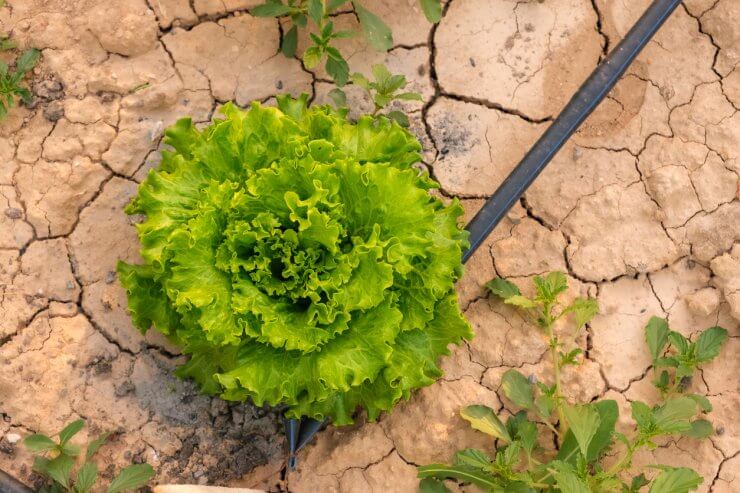
In community gardens across the American Southwest, a quiet revolution is taking place. Where traditional lettuce varieties once withered and bolted in the intense desert heat, gardeners are now harvesting crisp, sweet leaves well into the summer months. This transformation comes from combining advanced plant breeding with time-tested growing techniques, creating heat-tolerant lettuce varieties that can withstand temperatures that would cause conventional lettuce to bolt within days.
The science behind this breakthrough begins with understanding bolting – that crucial moment when lettuce decides it’s time to shoot up a flower stalk and turn bitter. It’s triggered by a complex dance between temperature, day length, and plant hormones. When temperatures rise above 80°F (27°C), most lettuce varieties produce increased amounts of gibberellic acid, a plant hormone that triggers reproductive growth. However, heat-tolerant lettuce varieties have genetic variations that help them maintain lower gibberellic acid levels even under heat stress.
For gardeners in USDA zones 7-10, where summer temperatures regularly exceed 85°F (29°C), growing heat-tolerant lettuce isn’t just a preference – it’s a necessity for maintaining a continuous harvest through the warm season. Even gardeners in cooler zones are finding these varieties increasingly valuable as climate change brings more frequent heat waves and unpredictable weather patterns.
Understanding Heat Tolerance in Lettuce
The science behind heat-tolerant lettuce varieties is that they have been adapted to thrive when others would bolt. These varieties typically have three key characteristics: delayed bolting response, improved water retention, and enhanced root systems. The genetics responsible for these traits often trace back to wild lettuce species that evolved in warm Mediterranean climates.
One particularly interesting adaptation involves the plant’s ability to maintain membrane stability at high temperatures. Regular lettuce varieties experience membrane damage when temperatures rise, leading to cellular leakage and eventual bolting. Heat-tolerant varieties produce specialized proteins called heat shock proteins that protect cell membranes, allowing the plant to continue growing normally even during heat stress.
The root systems of heat-tolerant lettuce varieties also play a crucial role. These plants typically develop deeper, more extensive root networks that can access cooler soil temperatures and maintain better hydration. This adaptation is particularly evident in varieties like ‘Nevada‘, which can continue producing crisp, sweet leaves even when surface temperatures soar.
Top Performers for Hot Weather
Through extensive trials in demonstration gardens, researchers have identified several standout heat-tolerant lettuce varieties that consistently perform well even during the dog days of summer. ‘Jericho‘, an improved Romaine type, originally developed in Israel’s hot climate, has become a go-to variety for reliable summer harvests. Its long, crisp leaves remain sweet even when temperatures exceed 90°F (32°C).
‘Australian Yellow‘ is another remarkable variety that challenges everything you might expect from summer lettuce. This historic variety produces tender, lime-green leaves with a buttery texture that persists through high temperatures. Its success lies in a genetic trait that reduces gibberellic acid production even under heat stress.
For those who prefer loose-leaf types, ‘Cherokee‘ offers exceptional heat tolerance along with stunning deep red coloration. The anthocyanin pigments that create its beautiful color also provide additional protection against heat stress – a fascinating example of how ornamental traits can contribute to practical benefits.
‘Sierra‘ and ‘Nevada‘ round out the top recommendations for heat-tolerant lettuce varieties. Both belong to the Batavian class, known for exceptional bolt resistance. Their slightly thicker leaves help retain moisture, while their compact growth habit provides mutual shading that helps keep root zones cool.
Cultural Practices for Success
While choosing the right varieties is crucial, success with summer lettuce also depends on understanding and implementing appropriate historical practices. Providing afternoon shade through techniques like shade cloth or companion planting can lower leaf temperatures by as much as 10°F (6°C), significantly extending the harvest window.
Soil management plays a vital role as well. Maintaining consistent soil moisture through deep mulching helps moderate root zone temperatures and provides the steady water supply these plants need. A 3-inch layer of straw mulch has the added benefit of reflecting some sunlight and reducing soil surface temperatures.
Succession planting takes on new importance when growing heat-tolerant lettuce in warm weather. Starting new seedlings every 10-14 days, beginning them in a cooler location and transplanting them into the garden as space becomes available ensures a continuous supply of young, sweet leaves even if older plants eventually succumb to the heat.
If you’d like to learn more about growing lettuce in your garden, check out our Lettuce Gardening Guide.
What have been your experiences growing lettuce in challenging conditions? Whether you’re gardening in the scorching Southwest or dealing with unexpected heat waves in traditionally cooler regions, which heat-tolerant varieties have performed well in your garden? Have you discovered any unique techniques for extending your lettuce harvest into the warm season? Share your successes and lessons learned in the comments below – there’s always something new to discover in the world of vegetable gardening.


 Previous
Previous

